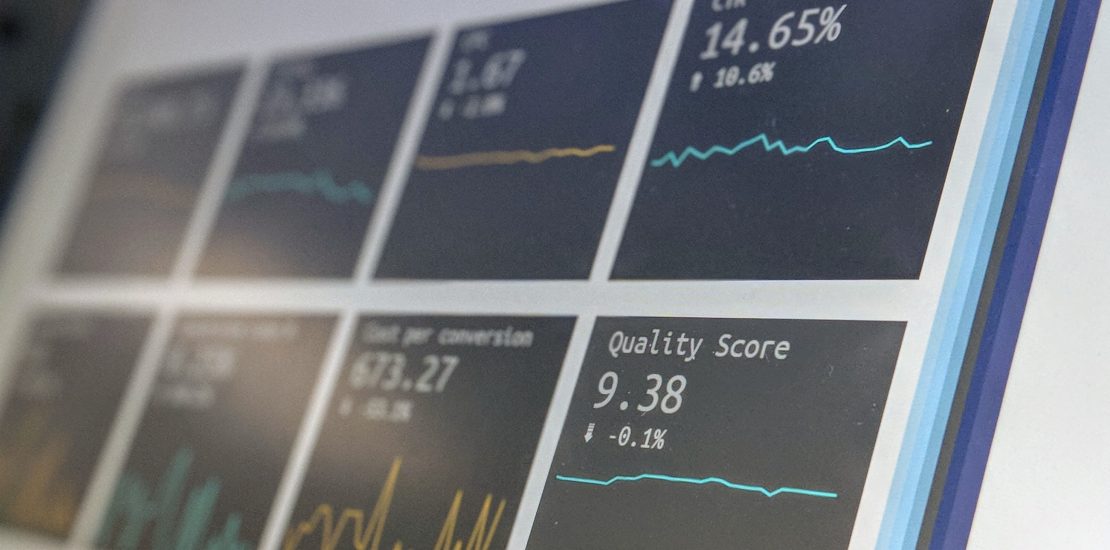Thought Leadership
What is Peppol?
June 04, 2021


With recent announcements from the Australian and New Zealand State and Federal governments continuing to push Peppol e-invoicing, there are many questions out there on what Peppol really is, where has it come from and how does it all work. To help guide businesses through this maze of information we take a deep dive into all things Peppol e-invoicing.
what is e-invoicing?
Over 1.2 billion Business to Business (B2B) and Business to Government (B2G) invoices are exchanged annually in Australia, the majority of those invoices are sent either as paper invoices or as PDF invoices attached to an email. These are costly ways to process invoices with manual data entry or validation usually required. The Australia Tax Office (ATO) estimate that:
- Average invoice processing cost for a paper invoice is $30.87 AUD
- Average invoice processing cost for a PDF invoice is $27.67 AUD
The majority of the costs is based on the usual manual work required to enter the invoice data into your systems and process it for approval and payment.
Electronic invoicing (or e-invoicing) is the automated digital exchange of invoice data directly between a buyer’s and supplier’s systems, removing the need for any manual data entry or validation. The ATO estimate that it can reduce the cost of processing an invoice down to $9.18 AUD. The NSW Government estimated a shared saving between suppliers and the NSW government of $71m AUD based on the 4.2 million invoices across NSW Government in 2019.
Are PDF Invoices e-invoices?
No, PDF invoices may be sent to someone electronically via e-mail, its not a system to system exchange of data that removes the need for any manual data entry or processing of an invoice.
how can you send an e-invoice?
E-invoices are not a new concept, they have been around for a while in a number of different formats, standards and names. Typically, they have been focussed on connecting a buyer with a supplier and have historically been quite expensive and time consuming to setup – this meant that it was largely only looked at by large businesses who had a big volume of orders or invoices. The lack of a consistent and single format and framework for e-invoicing has kept it from being mainstream.
The turning point for e-invoicing has been the adoption of a globally recognised standard for sending e-invoices and e-orders known Peppol (Pan-European Public Procurement OnLine). This standard enables anyone who is part of the network to easily and safely, send e-invoices and e-orders to each other. The standard also enables a simple and accessible way for businesses to be onboarded onto the network. There are already 200,000+ businesses across 34+ countries on the Peppol network. Australia, New Zealand and Singapore have all adopted this standard as the basis for their e-invoice mandates.
what is peppol?
Peppol is a globally recognised standard and process for exchanging e-invoices and e-orders which integrates the business processes of ordering and invoicing by standardising the way information is structured and exchanged.
Peppol consist of three main pillars:
- The Peppol Business Interoperability Specifications – which outlines the structure, format and data that needs to be exchanged for e-orders and e-invoices.
- The Peppol Network – the standardised way in which data is exchanged between buyers and suppliers
- The Peppol Governance Agreements – the policies, procedures and frameworks in place to ensure compliance amongst all parties.
The Peppol Business Interoperability Specifications
To ensure that e-invoices, e-orders and other e-documents can be easily exchanged between businesses there is a need for a common data structure and format. The Peppol Business Interoperability Specifications forms the basis for determining the format and structure of Peppol documents based on ISO/IEC 19845 Universal Business Language.
In less technical language this means that the specifications have been created based on well published and globally accepted data formats to ensure that the formats can be adopted by businesses. Fortunately for businesses there are providers, like Valtatech, who can support businesses to translate their existing orders and invoices into the required format.
The specifications have been developed to support a number of different business documents in the procure to pay ecosystem, following specifications are available in production environment:
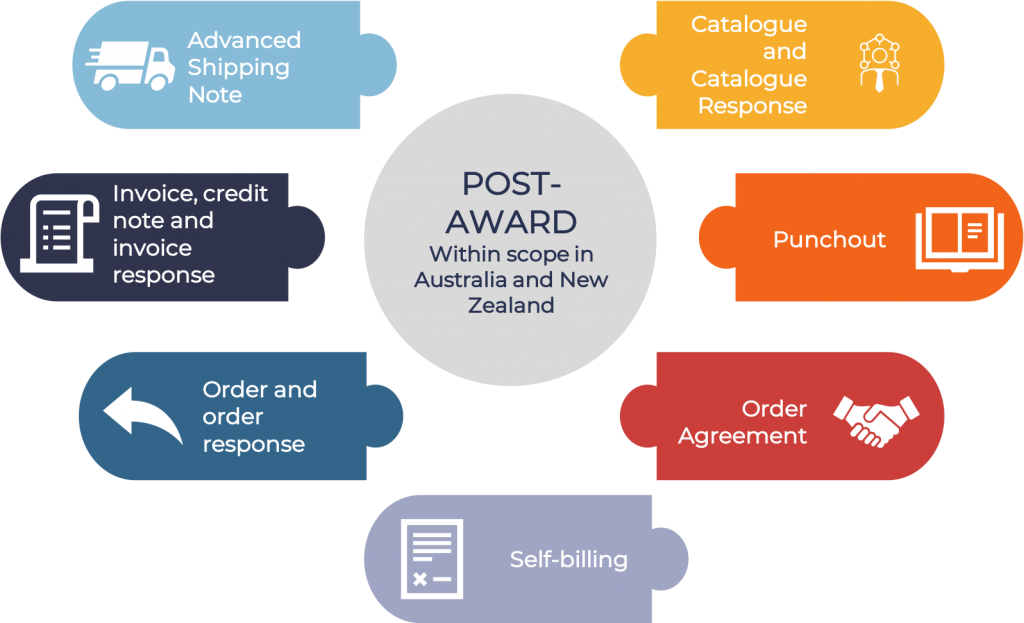
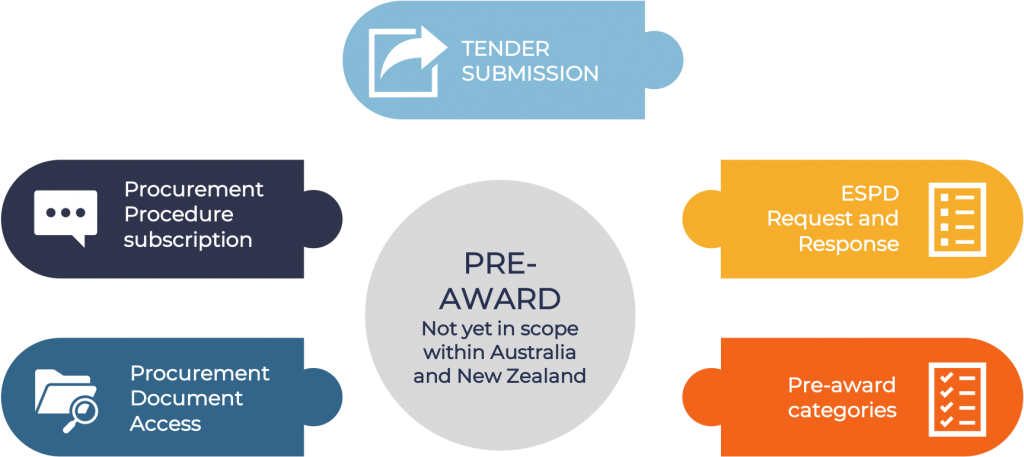
Pre-Award (Not yet in scope within A-NZ)
- Procurement procedure subscription – describes a process providing electronic messaging support for the business process of the subscription of an economic operator to a tendering procedure.
- Procurement document access – describes electronic messaging support for the business process where an economic operator requests the status of a procurement project from the contracting body, who provides the economic operator with the latest procurement project metadata by call for tender message.
- Tender submission – describes electronic messaging support for the business process of an economic operator submitting electronic tender to a contracting body, as a response to a call for tender. The contracting body notifies the economic operator of having received the tender.
- ESPD request & response – describes European Single Procurement Document
- Pre-award catalogues – describe a common format for the pre award catalogue messages in the European market, and to facilitate an efficient implementation and increased use of electronic collaboration regarding the tendering process based on these formats.
Post-Award (In scope within A-NZ)
- Invoice, credit note and invoice response – a common format for invoice, credit note and invoice response messages with billing process where a seller issue an electronic invoice or credit notes to an earlier invoice, whereby the buyer may accept, reject or dispute the invoice. There are different variations of these for Europe, Singapore and A-NZ. Right now, the main focus is with these processes in A-NZ.
- Order and order response – a common format for the order and order response message with ordering process where a buyer issue an electronic order, whereby the seller may accept the order, accept with changes or reject.
- Advance Shipping Note – a common format for the advance shipping note with fulfilment process which is used by the supplier to notify the receiver about, the despatch and delivery period for the goods being sent, as well as details about the goods for cross checking with the order and for declaring how the despatched goods are packed.
- Catalogue and Catalogue response – a common format for the catalogue message with sourcing processes for suppliers to send a catalogue and for buyers to return a catalogue response.
- Punchout – a common format for the shopping cart with processes where the buyer accesses the seller’s web-based catalogue and configures items (such as a PC) to a product or service list. The product or service lists are sent to the buyer’s procurement system and can later be used as a basis for an order or an item comparison in the buyer’s catalogue tool. The order is prepared and sent from the buyer’s procurement system, not from the sellers website.
- Order Agreement – a common format for the order agreement with processes where the buyer, after purchasing items/services, receives a message with information documenting the purchase.
- Self-billing – a common format for the self-billing with processes where the buyer bill themselves instead of supplier sending the invoice. This is special optional document for the use in A-NZ.
The Peppol Network
The Peppol network is very much the glue that connects the different business documents together, providing a reliable, secure, safe and standardised way to exchange documents. Suppliers and buyers send their invoices or orders through their systems to a certified Peppol Access Point. The Access Point verifies the data on the invoice or order and then sends it on to the receivers certified Access Point who transmits the data into their system. This means that data is shared almost instantly into the receivers system without any manual data entry or manipulation required.
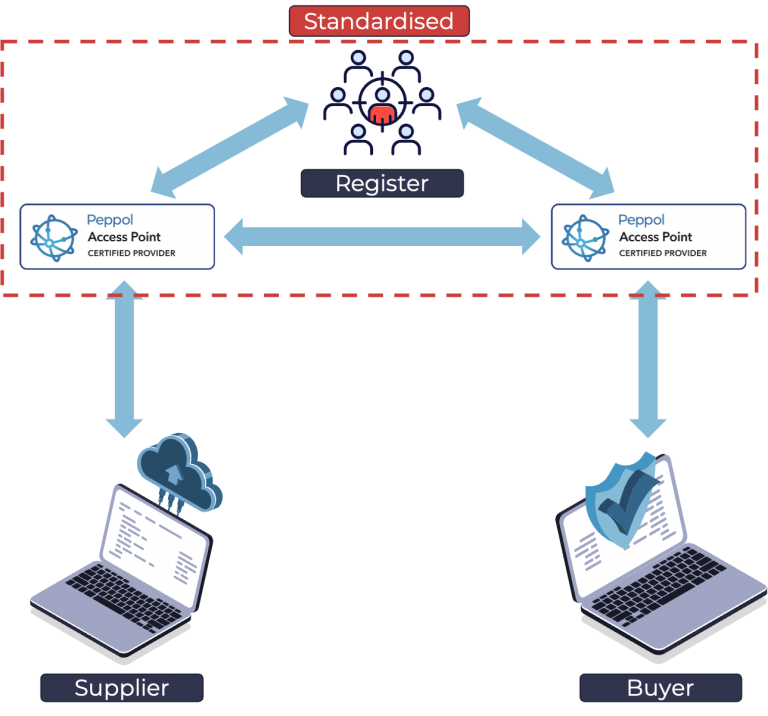
Evolution of Peppol network (# of receivers in Peppol)
- 2012 1,355 receivers of Peppol business documents
- 2013 9,728 receivers of Peppol business documents
- 2015 42,042 receivers of Peppol business documents
- 2018 168,944 receivers of Peppol business documents
- 2019 225,000 receivers of Peppol business documents
- 2020 300,000 receivers of Peppol business documents
- 2021 450,000+ receivers of Peppol business documents
The Peppol Governance Agreements
To ensure the validity, security and compliance with the network, Peppol has a very strong governance structure in place. These governance agreements ensure compliance to the standardisation that is required for all stakeholders and are established and governed through legally binding multi-lateral agreements.
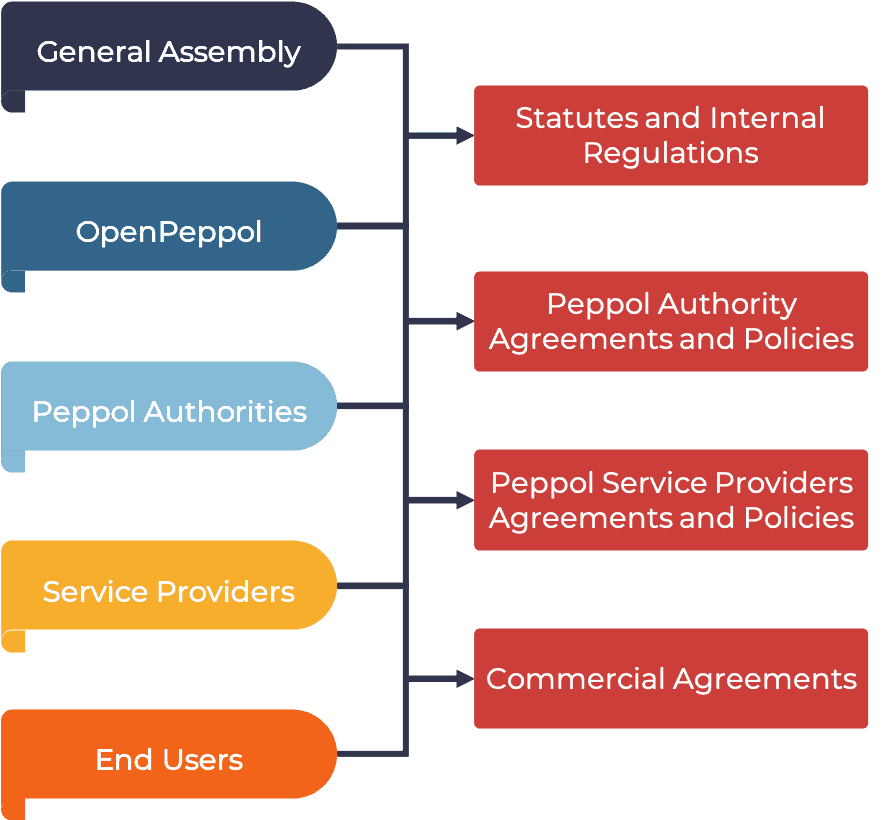
- General Assembly: OpenPeppol members form the general assembly in accordance with OpenPeppol statutes and internal regulations, elects the general secretary, managing committee and election committee.
- OpenPeppol: is a not-for-profit, democratic, member-led international organisation to enable and govern e-invoicing & e-procurement across the globe using the Peppol interoperability framework. It is based in Brussels and was established under Belgian law in 2012.
- Peppol Authorities: Peppol authorities drive the adoption of Peppol in a jurisdiction. They are currently all government agencies. Australian Taxation Office (ATO) is the Peppol Authority in Australia and Ministry of Business, Innovation and Employment (MBIE) is the Peppol authority in New Zealand. These Peppol authorities are also OpenPeppol members and operate under standard bilateral legal agreement with OpenPeppol.
- Peppol Service Providers: Peppol Service providers enable business process interoperability between end users over Peppol network via Peppol BIS. These are sometimes also called as Peppol Access Points (APs) or Service Metadata Publishers (SMPs), are OpenPeppol members and operate under standard bilateral agreements with a Peppol Authority.
- End Users: These are buyers and sellers that exchange business documents and are also known as participants in the Peppol network. These can be members of OpenPeppol but are not required to be. End users get into commercial agreements with Service Providers for availing Peppol services.
Peppol Organisation Structure:
OpenPeppol govern and regulate the Peppol interoperability framework through organisation structure below:
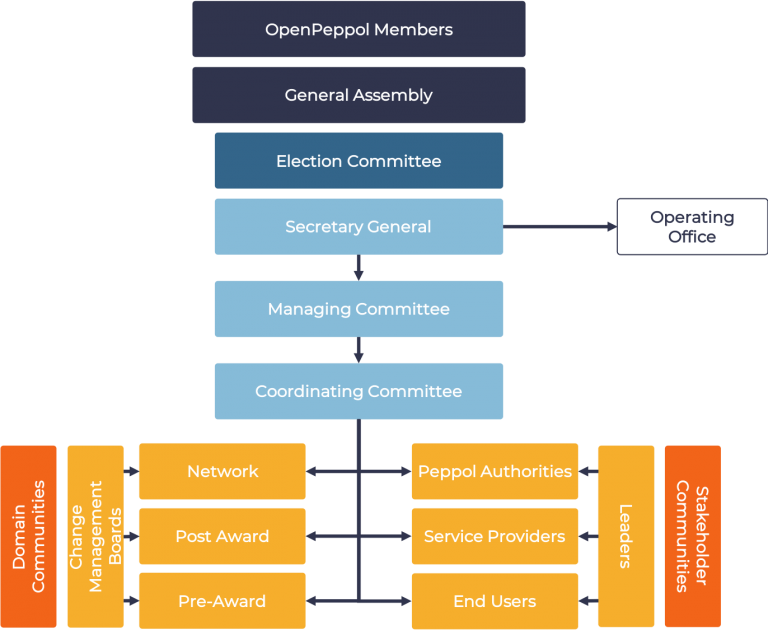
The Evolution of Peppol
The Peppol network and interoperability framework has evolved dramatically since its inception in 2008. It was started a pilot project by European commission in 2008 with focus on cross border public procurement in Europe. It was started as an acronym PEPPOL for (Pan European Public Procurement OnLine), managed by OpenPeppol since 2012 and being rebranded as Peppol since its expansion to private sector, domestic use within countries and outside Europe.
- 2008 PEPPOL pilot by European commission
- 2010 First live transaction
- 2011 PEPPOL e-invoicing mandate in Norway
- 2012 OpenPeppol established
- 2013 AS2 protocol released
- 2015 Peppol BIS 2.0 released, 5 Peppol Authorities
- 2018 11 Peppol Authorities, Peppol adopted in Singapore, New OpenPeppol Statutes.
- 2019 Peppol BIS 3.0 released, Peppol adopted in Australia and New Zealand
- 2020 AS4 protocol released and 15 Peppol Authorities
- 2021 New Peppol Agreements in line with Peppol expansion globally
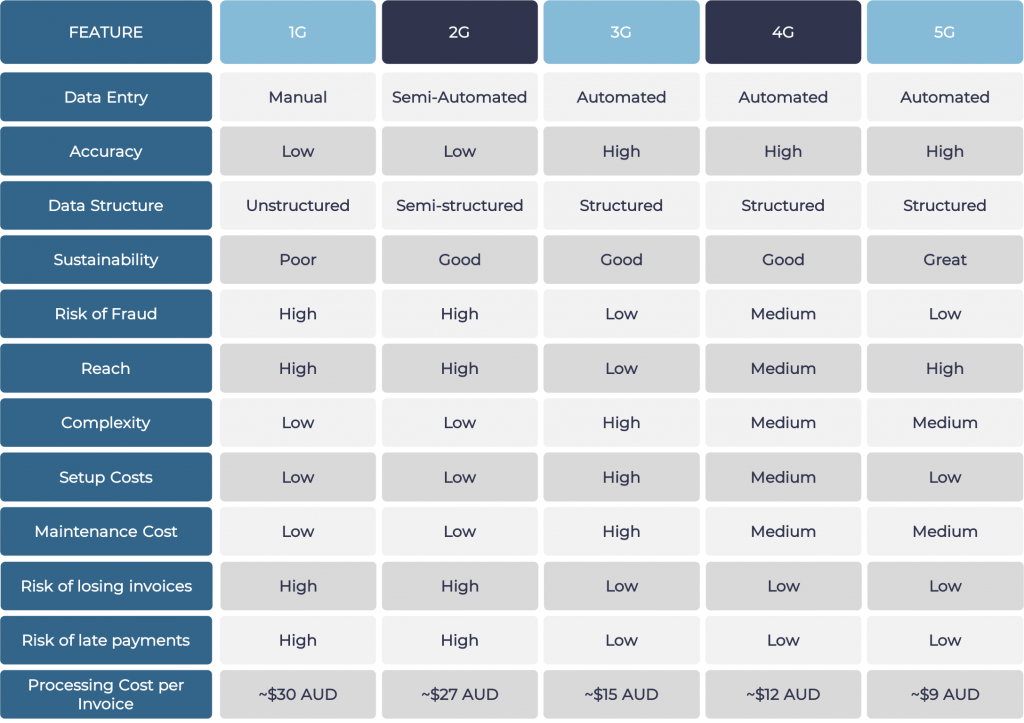
what are the benefits of e-invoicing?
The Australian government believes that e-invoicing can save the economy $28bn over 10 years. Sounds great, but what are the actual benefits and why would businesses want to be able to send and receive Peppol e-invoices? The first thing to consider about Peppol e-invoicing is how you are currently processing invoices.
Our resident e-invoicing experts pulled together a detailed overview of how invoicing has evolved and assessed each evolution of that option across a number of key factors:
Depending on which invoicing method you are currently using, the benefits of shifting to Peppol e-invoicing can be huge. Typically, we find that Peppol e-invoicing (and e-ordering) can help support businesses with a range of challenges they face today:
challenge: large supplier base making invoice automation impossible and too expensive
Utilising Peppol e-invoicing, once you are connected to the Peppol network through an Access Point, you are automatically connected with every other buyer and supplier in the network – greatly enhancing your ability to automate invoice processing with all your suppliers. If your trading partner is not on the Peppol network yet, we can help onboard them which doesn’t require any investment from you or your trading partners.
challenge: high risk of invoice fraud
PDF invoices can easily be intercepted mid-flight and manipulated before being received by the buyer and email compromise scams like this are on the rise, a topic we wrote about recently. With Peppol e-invoicing, the sender is validated to ensure they are who they say they are and that bank account details match your records before transmitting the data through the Peppol network.
The network itself is highly secure as only accredited Peppol Access Points providers can exchange the documents over the Peppol network. Access providers like us are required to meet strict security protocols equivalent to ISO27001 covering intrusion prevention, multi-factor authentication for privileged user access and data encryption to ensure the security of the network.
challenge: cash flow management during the pandemic
Businesses can be crippled when buyers pay them late, invoices can get missed when it’s reliant on human intervention. Equally, buyers can miss out on early payment discounts if the invoice is lost or not processed quickly. E-invoicing speeds the whole invoice processing piece up for both sides, removing the worry of whether an invoice has been received and processed or not. In Australia, Commonwealth and NSW government agencies guarantee 5-day payment terms for e-invoices which makes e-invoicing even more attractive.
Peppol adoption in Australia and New Zealand:
On 22.02.2019, in a joint statement, the Australian and New Zealand Prime Ministers, Scott Morrison and Jacinda Ardern announced the creation of the Australia and New Zealand Electronic Invoicing Board (ANZEIB) to help drive an estimated A$30 billion in savings over 10 years in Australia and New Zealand. They also announced the two countries’ intention to jointly adopt the Peppol interoperability framework for trans-Tasman e-invoicing.
Australian Taxation Office (ATO) from Australia and Ministry of Business, Innovation and Employment (MBIE) from New Zealand has taken up the role of Peppol authorities to increase the adoption of Peppol in Australia and New Zealand.
There are several Peppol e-invoicing mandates lined up in Australia with some of commonwealth agencies to be ready for Peppol e-invoicing by 1st July 2021, rest of commonwealth agencies by 1st July 2022 and NSW government agencies to be ready by 1st Jan 2022. Read our blog on what that means for your businesses here.
Where does Valtatech fit into the Peppol Organisation
We are certified Peppol Service Provider across the globe.
We are also accredited for Peppol & e-invoicing services in Australia and New Zealand
We support all post-award documents described above.
We are member of all Peppol domain communities: Network (aka eDec), Post-award and Pre-award.
We are members of OpenPeppol Service Providers community.
We are part of OpenPeppol general assembly with voting right to contribute to the direction of the organization. OpenPeppol 13th General Assembly is upcoming on 15th
Our team brings in wealth of Peppol experience from overseas since its early days from 2012 including experience as elected service providers’ representative in the OpenPeppol election committee safeguarding the democracy of the OpenPeppol organization.
Our Head of e-Invoicing, Manjeet Yadav is also running for his candidacy in OpenPeppol governance in the upcoming 13th OpenPeppol General Assembly.
We hope that this has helped to clear up what Peppol is, how this regions adoptions fit in to a global initiative and where Valtatech is positioned in the Peppol community. Still a little confused or have some questions? We’d love to chat!

